
Testing A Dynamo & Regulator
Andrew grew up on a dairy farm and completed his first tractor engine rebuild around 50 years ago. With a degree in engineering Andrew, now retired, has time to pursue his interest in tractor restoration. Currently restoring IH tractors ’61 B275, ’67 B434 - Andrew has contributed to the International B Series Tractors Group and a number of instructional files to the International Harvester Club of Great Britain.
WARNING – When testing a dynamo take great care with the drive belt, pulley and fan to ensure that body parts or clothing are not caught or dragged in.
Ground Rules
Tractor dynamos convert external power via a belt to electrical power. They are relatively efficient, possibly between 80 and 90%. A dynamo outputting 14 volts and 30 amps is producing 420 watts. At 90% efficiency this would require 420/.9 or 467 watts from the engine… a little over 0.6 hp.
When a belt squeals it is slipping because it cannot transmit this power. A cold engine just started has discharged the battery and the dynamo at this point is asked to provide its maximum output, often with a damp belt and pulleys.
Types of Dynamo
The dynamos fitted to UK built tractors in the 50’s and 60’s were often supplied by Lucas and were very similar or identical to those on cars in the same period. Operation of all dynamos and their regulators is essentially the same so these notes apply equally to other makes.
Fig 1 shows a common Lucas car version (also fitted to some tractors) which was ventilated with non-solid end plates that allowed additional cooling as shown here. These units often had an oil hole in the end as seen in the photograph.
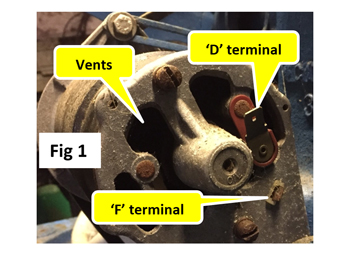
Some tractors were fitted with non-ventilated types as shown in Fig 2. The reduced cooling resulted in these tractor units typically being rated at 11 Amps while the vented were mostly rated at around 22 Amps or more. Electrically the two types would appear to be identical so the differences in practice come down to the type of regulator fitted – more on this later..
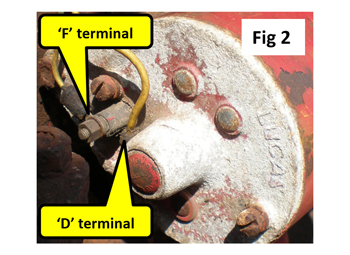
Some dynamos even have a tachometer gearbox fitted to the end as shown in Fig 3 but otherwise operate as the other types.
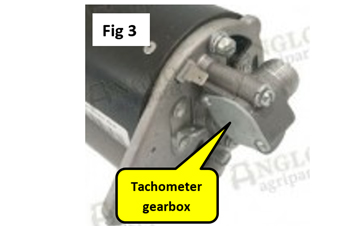
Connections can be by push-on spade as in the first example or bolted-on ring terminals as in the second. Often faults can be as simple as loose connections on the dynamo.
Regulators
There are many different types of regulator, some in sealed metal cans, some in plastic and some with removable covers. Connections can be by spade, screw or a folded wire bullet as shown in this four terminal version.
While many regulators have only four terminals, several have six. To add slightly to the complexity, connections having the same function may have a different name, - and that is without the possibility that it is in a different language for a foreign tractor. This table gives the most common usage.
This diagram is for the six terminal type of regulator where the connections here marked as ‘B’ could alternatively be marked ‘A’ and ‘A1’. On a four terminal regulator the ‘W/L’ and second ‘B’ (or ‘A’) terminal is unused – the single ‘A’ (or ‘B’) terminal does both jobs.
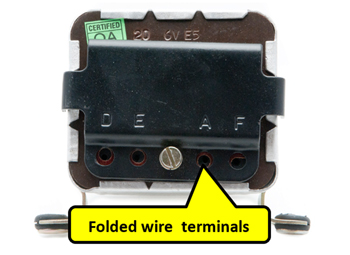
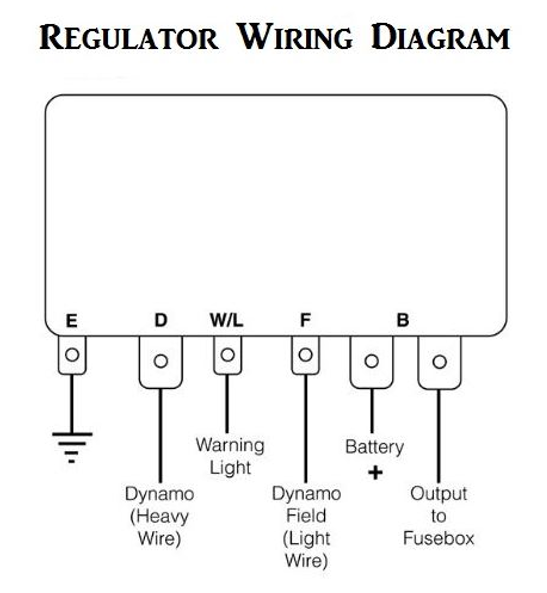
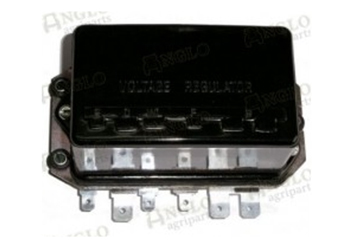
Not all voltage regulators sold as suitable replacements are directly equivalent. One bought via the internet was quoted as the correct part for the tractor, a description which was only partially correct. The regulator would work with the dynamo but was actually for a vented version in that its nominal current was 22, not 11 Amps, pushing out a good 30 Amps when the engine was first started. The regulators are intended to allow higher charging currents when everything is cold to help recharge the battery after cold starting demands then, as the regulator heats up, the maximum current is reduced to the standard rating (11 or 22 Amps here.)
In UK temperatures there doesn’t initially seem to be immediately obvious overheating problem when running the non-vented dynamo at these higher currents. The dynamo pictured here had been run in this configuration for a couple of years without apparent problems until it was examined internally. On dismantling the dynamo, a ring of fine solder splashes was found indicating that the commutator solder became hot enough to soften if not fully melt, not ideal for long term reliability. So, if the dynamo is non-vented and charges at over 15 Amps, the regulator is either broken or the wrong model.
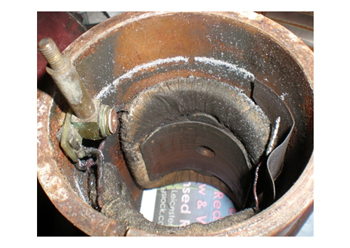
On-tractor Testing
If smoke or flames are coming out of the dynamo, this is a clear indication that it is faulty! Discontinue immediately and either replace or investigate… but the dynamo is probably beyond economic repair.
Assuming everything externally looks ok, simple checks with a multi-meter (DVM) should enable the problem to be isolated. The multi-meter doesn’t need to be expensive – this one was available via the internet for under £6 at the time of writing. It is also worth getting or making leads with crocodile clips to leave hands free.
There are two different ways to test a dynamo – a quick and rough test of the dynamo only and a detailed test (based on the original Lucas procedure.) Both are described below.
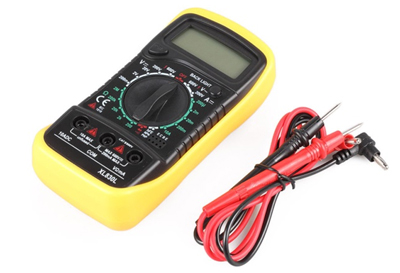
Quick Test
-
Ensure the engine is stopped
- Check that the dynamo belt is serviceable and correctly adjusted – ½” to 1” movement when moved up and down… and that the fixing bolts are secure . Too tight a belt leads to belt wear and overloads bearings. Too slack a belt leads to slip, belt wear and reduced dynamo output.
- Disconnect both field (the thinner wire with smaller spade or ring connector) and power connections (thicker wire with larger ring or spade connector) ensuring that they don’t short to surrounding metalwork in case there is also a regulator fault.
- Start the tractor and run at low speed (about 600 RPM).
- Measure the voltage between the power terminal and earth – this is typically 2 or 3 volts but may initially be lower.
- Link the field and power terminals with a piece of wire, taking care not to short either terminal to earth. The voltage should rise (possibly to around 8 or 9 volts.) Raise the engine speed slowly and the voltage should rise – take care not to exceed 20 volts or there is a risk of damage to the dynamo’s insulation.
- Listen to the dynamo for noisy bearings – even if working electrically then a mechanical repair may be needed.
If the above works then the dynamo is capable of providing power although this test doesn’t confirm that it can deliver its full rated output current.
If this doesn’t work, the dynamo may need re-polarising… resetting its residual magnetism. This is also sometimes necessary if the tractor’s battery polarity is changed for any reason, e.g. changing from positive to negative earth. To do this, connect a wire to the non-earth side of the battery then quickly touch the other end to the field terminal – a fraction of a second is all that is necessary then repeat the simple dynamo check above.
Detailed Test
The following test procedure is that advised by Lucas in the 1960s.
Again, ensure the engine is stopped.
- Check the belt tension (approximately ½” to 1” movement) and ensure the fixing bolts are secure.
- The DVM should normally be used on a 20V range.
- If the tractor has a positive ground, the positive lead of the meter is connected to ground and the negative used for measurements to get positive readings. The DVM will however work safely either way round, just the values will be shown as negative.
- Attribution – you must give appropriate credit and provide a link to the original article in a reasonable and visible manner
- You may not in any way suggest that the licensor endorses you or your use.
- No Derivatives – The material must be distributed in full, including disclaimer, you may not distribute or share modified material.
- No additional restrictions – You may not apply legal terms that legally restrict others from doing anything the licence permits.
- No warranties are given. The license may not give you all of the permissions necessary for your intended use. For example other rights such as publicity, privacy, or moral rights may limit how you use the material.

ARTICLE CONTRIBUTED BY ANDREW CHAPMAN
© ANDREW CHAPMAN & ANGLO AGRIPARTS LTD


Licence Terms
You are free to: Share, copy & redistribute the material in original format for any purpose as long as you follow the license terms below:
Disclaimer





